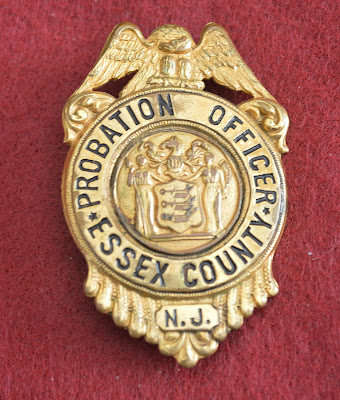By: Dennis Beyer
Today is my birthday and I still enjoy the memories I have of my early career. Its hard to believe they were 55 years ago! Here is a memory that often flashes in my mind. Let me share it as the world has changed since my early work days.
It was 1967. I was just beginning my third year, as a Probation Officer.
I was assigned to an area designated "J-15" on Newark's South Side. Pictured above is the badge I carried. I still have it, and of course it is framed.
In my assignment duty the "J (stood for juvenile), and the 15" designated a specific geographical
section of the City. Newark had multiple geographical areas designated
for supervision relating to juvenile supervision by the probation department.
The crime problem was such, that these
geographic sections were measured by City blocks, as opposed to miles.
The J-15 area had between 80 to 100+ offenders at any given
time. That made it easy to get mugged on any given day.
My Office was in an old medical building converted to a satellite office for probation staff. It was located at 32
Johnson Ave. Up the street was South Side H.S. It was renamed, circa 1967, Malcolm X.
Shabazz High School.
Down the street from the office was Peterman's Diner. This was a daily coffee stop. Ten O'Clock it was packed. Today it's no longer in business.
Back
up the street, next to our office, was a six or seven story apartment
building. It had a great view of our parking lot.
One afternoon, in the early part of 1967, I observed a large amount of
glass on the pavement near my car. Other officers had also observed this in our parking lot.
The broken bottle situation occurred about two months prior to the
riots. We believed a kid or two were tossing bottles from one of the
apartments.
We watched from our office windows. Finally we saw where
the bottles where coming from. A call was made to N.P.D. and our
Sheriff's office.
Officers responded very quickly, and entered the
apartment building that was the source of these thrown bottles.
Inside they found a woman and her two sons. They were practicing making,
and throwing Molotov Cocktails. They also possessed, what was
described in 1967 terms, as "radical material." An immediate arrest was made.
Around this same time frame this writer was assigned a routine investigation for "courtesy supervision of an out of State case".
The State of Alabama asked us to check out and accept responsibility for one of their "lads." The kid was only 12.
He had "made some mistakes" down South, and a change in scenery was
supposed to help.
The boy's family had an apartment in the "Clinton Hill" section of the City. That meant that this was going to be a routine acceptance for out of state supervision.
Everything checked out, except the kids "s.o.b." brother, for whom, I
immediately disliked. He carried a knife. That was unacceptable, even in 1967. I confiscated the large blade he held while partially hiding behind a drape. That should have been the end of the story, but
there was more a couple months later.
It was July, while in the
Bahamas (honeymoon time), I observed a news paper, in a store, with the headline: "RIOT"S IN NEWARK." It
was no surprise. The report indicated fatalities in my City, along with multiple arson's, and looting.
By time the honeymoon was over, the death toll was "officially" just
under 30. A Newark Police Officer, and a Newark Fireman were among the
dead. I knew the Fireman's family from Church.
Returning to the job in early August, another investigation was assigned to me.
It too came as an official request from the State of Alabama. They were inquiring, this time, as to the "status" of
the young boy they shipped off to Newark, N.J.
Along with this assignment was a
LIFE Magazine. It was dated July 28, 1967.
The Magazine Cover showed the
body of "Guess Who?" It was the same 12 year old boy I checked out a
couple of months earlier. He was now laying on a street in Newark, a
shooting victim of the riots. He appeared dead, laying in a pool of blood. The magazine is pictured above. I still have it.
Life Magazine did not report that the boy only had minor injuries. He was treated for superficial wounds. He was released from the hospital a few days later.
In professional jargon the State of Alabama was advised that their
interest was: "Alive and well, and raising hell."
A lot of people were
raising hell during those terrible days of July 1967!
There
were so many arrests that the Newark Street Jail was bursting. This
was a County facility located in the City.
The Roseville
Armory, also inside the City, was pressed into service to handle the
"overflow" arrests. The prisoner population exceeded the 1000 mark.
The
Courts ran overtime to free up space at the holding locations for fear of
another riot inside.
Any kind of story got a prisoner out of jail back then. On the lighter side, I recall a story of a defendant charged with pushing a refrigerator, away from an
appliance store at "2:00 am." He explained, to the judge, that: "I
bought it this afternoon, but they don't deliver."
The City looked like hell.
It would take forever to bring Newark back to life as a big time City.
As a result of
Newark's insurrection during that hot July in 1967: Cars were burned;
Houses were burned; City blocks were burned; Windows were smashed;
Businesses were looted; People disappeared: and, sadly in the end, People
died.










































